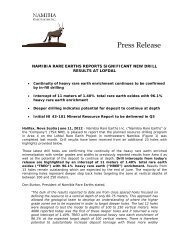Namibia Rare Earths Files Technical Report for Initial Mineral ...
Namibia Rare Earths Files Technical Report for Initial Mineral ...
Namibia Rare Earths Files Technical Report for Initial Mineral ...
Create successful ePaper yourself
Turn your PDF publications into a flip-book with our unique Google optimized e-Paper software.
3<br />
Area 4 <strong>Mineral</strong> Resource Program<br />
This is an initial mineral resource estimate, and the first ever provided from Lofdal. There<br />
are no historic rare earth mineral resource estimates known from the property. <strong>Namibia</strong><br />
<strong>Rare</strong> <strong>Earths</strong> recognized the potential of the Lofdal carbonatite complex as a new rare earth<br />
mineral district covering over 200 km 2 in 2008 and set about demonstrating this potential<br />
through systematic geological mapping and sampling over a period of two years be<strong>for</strong>e<br />
drilling the first core holes in October of 2010. The mineralized outcrops, in what is now the<br />
Area 4 mineral resource area, were not sampled until late 2010 and the first drill holes were<br />
only completed in June 2011. Since January of 2012 the Company has dedicated most of its<br />
resources towards the development of a NI 43-101 compliant mineral resource on the heavy<br />
rare earth-enriched mineralization in Area 4. The geological database supporting the initial<br />
mineral resource estimate is detailed and is of a high quality, comprising over 10,025<br />
meters of diamond drilling in 93 holes and 987 meters of trenching (Figure 2).<br />
Significance of the <strong>Mineral</strong> Resource Estimate<br />
Although mineral resource grades (% TREO) are relatively low, the high levels of heavy rare<br />
earth enrichment can provide significant tonnages of contained heavy REOs. The main<br />
elements of interest from the Area 4 mineral resource are europium, terbium, dysprosium<br />
and yttrium (with yttrium and dysprosium being the most abundant). Based on the REO<br />
distributions, these four elements are the most valuable in the deposit (Table 4). The<br />
tonnage of the mineral resource is particularly sensitive to cut-off grade as can be seen<br />
from Table 2. It is there<strong>for</strong>e of particular interest to determine if viable extraction of the<br />
rare earths can be achieved at the lower grades.<br />
Carbonatite deposits are known to be naturally anomalous in thorium and details of the<br />
concentrations of both thorium and uranium within the calculated mineral resources are<br />
presented in Table 3. Thorium concentrations at the reported cut-off grades range from 297<br />
ppm to 531 ppm which would not be considered abnormally high, however, the removal of<br />
thorium must be addressed in metallurgical studies.<br />
It remains to be demonstrated that the rare earths can be extracted from the mineral<br />
resource at Area 4. This is the current focus of the Company’s work through the<br />
metallurgical program developed by Mintek <strong>for</strong> the Area 4 mineral resource as described<br />
below.<br />
<strong>Mineral</strong> Resource Classification<br />
The mineral resource has been presented using a range of cut-off grades considered<br />
appropriate <strong>for</strong> the deposit type and the characteristics of the rare earth mineralization in<br />
Area 4, and is currently classified as Indicated and Inferred following guidelines<br />
recommended under CIM Standards on <strong>Mineral</strong> Resources and Reserves. Regarding the<br />
Area 4 mineral resource classification, MSA makes note that portions of the current<br />
classifications of Indicated and Inferred could be upgraded to the Measured and Indicated<br />
categories upon receipt of an independent qualified metallurgical report indicating that the<br />
deposit has reasonable prospects <strong>for</strong> economic extraction. The level of confidence in the<br />
geological model with respect to quantity, grade or quality, densities, shape, and physical<br />
characteristics is currently sufficient such that further drilling would not be deemed<br />
necessary to upgrade portions of the current mineral resource to Indicated and Measured.




